Geomorphological Heritage in Viñales National Park (Aspiring UNESCO Geopark): Geomatic Tools Applied to Geotourism in Pinar del Río, Cuba
Abstract
1. Introduction
- Viñales polje (AIG-1) with two sub-areas: AIG-11(PIG-1 Valle de Viñales, PIG-2 Valle del Silencio, PIG-3, Cueva Palmarito), AIG-12 (PIG-4 Valle Dos Hermanas, PIG-5 Mogote Dos Hermanas).
- San Vicente Polje (AIG-2), with two subareas: north and south. AIG-21 (PIG-6, Puerta de Ancón, PIG-7, Cueva Geda. AIG-22 (PIG-8, Cueva del Indio, PIG-9, Balneario San Vicente).
- Santo Tomas Polje (AIG-3) (PIG-10, Valle de Santo Tomás, PIG-11, Cueva de Santo Tomás, PIG-12, Límite Cretácico-Paleógeno K/Pg).
- La Jutía Polje (AIG-4), (PIG-13, Hoyo de Jaruco, PIG-14, Valle de la Jutía).
- Ancón Polje (AIG-5) (PIG-15, Valle and upwelling (Surgencia) de Ancón, PIG-16, Abra de Ancón),
- La Cuevita Polje (LIG-1)—(PIG-17, Valle de la Cuevita).
- Pan de Azúcar Valley (LIG2) (PIG-18, Mogote de Pan de Azúcar, PIG-19, Resolladero Pan de Azúcar) and LIG-3 Boquerón del Infierno—El Sitio (PIG-20).
Geological and Geomorphological Framework
2. Methods
3. Results
3.1. Description of the Selected Areas, Places and Geosites
3.1.1. AIG 1. Viñales Polje
3.1.2. AIG 1.1 Viñales Valley
3.1.3. AIG 1.2. Dos Hermanas Valley
3.1.4. AIG 2 San Vicente Polje
3.1.5. AIG 2.1 San Vicente Sur Valley
3.1.6. AIG 2.2 North San Vicente North Valley
3.1.7. AIG 3 Polje de Santo Tomás
3.1.8. AIG 4 La Jutía Polje
3.1.9. AIG 5 Ancón Polje
3.1.10. LIG 1 La Cuevita-Loma del Mango Polje
3.1.11. LIG 2 Pan de Azúcar Valley
3.1.12. LIG 3 Inactive Fluvial Valley
3.2. Valorisation of Geosites
4. Discussion
4.1. Geological–Geomorphological Itineraries
4.1.1. Conventional Itineraries (Field Trips)
4.1.2. Virtual 3D Itinerary
5. Conclusions
- This paper provides cartographies with various thematic (geological, geomorphological, and morphotectonic) maps necessary for implementation in the 3D virtual itinerary. In addition to the morphology of the hills (mogotes), the cartography of the Viñales valley represents the Quaternary deposits that form the bottom of the polje, assigning them Early, Middle and Late Pleistocene and Holocene ages.
- Classification and valorisation of geosites. They were ranged according to the total value of the sum of the values of the scientific, didactic and tourism interests. The maximum value is 1030 for geosite 1 (Viñales valley) and the minimum is 365 for geosite 14 (La Jutia valley). As for areas and localities, values range from 2190 (Santo Tomás polje) to 675 (La Cuevita polje).
- The comparison of the values in this paper and those by Vázquez Torres and collaborators indicates that, even using similar methodologies, there are significant differences concerning the valorisation. These were attributed to the different focus, this paper being more geomorphological and the other more general.
- The 3D virtual itinerary allows for the diffusion of the knowledge of the geological–geomorphological heritage with geomatics elements that provides a better understanding of the Viñales National Park. It also contributes to a better sustained development of this area, as it provides a simple way to access the telematics information in portable devices, which favours usage not only by scientific, educational and touristic entities but also by the general visitors, as they will have an individual auto-guide to roam the geosites by means of the GPS of the mobile devices.
Author Contributions
Funding
Data Availability Statement
Acknowledgments
Conflicts of Interest
References
- Brilha, J.B. Inventory and Quantitative Assessment of Geosites and Geodiversity Sites: A Review. Geoheritage 2015, 8, 119–134. [Google Scholar] [CrossRef]
- Newsome, D.; Dowling, R.K. Geotourism: The Tourism of Geology and Landscape; Goodfellow Publishers: Oxford, UK, 2010. [Google Scholar]
- Reynard, E.; Brilha, J. Geoheritage: Assessment, Protection, and Management; Elsevier: New York, NY, USA, 2017. [Google Scholar]
- Ruban, D.A. Geotourism—A geographical review of the literature. Tour. Manag. Perspect. 2015, 15, 1–15. [Google Scholar] [CrossRef]
- Zouros, N. The European Geoparks Network—Geological heritage protection and local development. Episodes 2004, 27, 165–171. [Google Scholar] [CrossRef]
- UNESCO Global Geoparks. 2023. Available online: https://en.unesco.org/global-geoparks (accessed on 10 February 2023).
- Quesada-Román, A.; Pérez-Umaña, D. State of the art of Geodiversity, Geoconservation, and Geotourism in Costa Rica. Geosciences 2020, 10, 211. [Google Scholar] [CrossRef]
- Rosado-González, E.M.; Sá, A.A.; Palacio-Prieto, J.L. UNESCO global geoparks in Latin America and the Caribbean, and their contribution to agenda 2030 sustainable development goals. Geoheritage 2020, 12, 1–15. [Google Scholar] [CrossRef]
- Quesada-Román, A.; Torres-Bernhard, L.; Ruiz-Álvarez, M.A.; Rodríguez-Madariaga, M.; Velázquez-Espinoza, G.; Espinosa-Veeg, C.; Toral, J.; Rodríguz-Bolaños, H. Geodiversity, Geoconservation, and Geotourism in Central America. Land 2021, 11, 48. [Google Scholar] [CrossRef]
- Goy, J.L.; Martínez-Graña, A.M.; Cruz, R.; Andrés, C.; Martínez-Jaráiz, C. Inventario y Catalogación Cartográfica del Patrimonio Geológico (Científico y Didáctico) de la Reserva de la Biosfera de las Sierras de Béjar y Francia. In Colección Patrimonio Geológico; Instituto Geológico y Minero de España (IGME): Madrid, Spain, 2012; Volume 1, 120p, ISBN 978-84-615-9656-0. [Google Scholar]
- Goy, J.L.; Corvea, J.L.; Martínez-Graña, A.M.; de Bustamante, I.; Diaz-Guanche, C.; Zazo, C.; González-Delgado, J.A.; Herreros, E.; Blanco, A. Patrimonio Geológico del Parque Nacional Viñales (Pinar del Río, Cuba): Itinerario Virtual para el Geoturismo y la Geoconservación. X Congreso de Áreas Protegidas; La Habana, Cuba, 2017. [Google Scholar]
- Corvea, J.L.; Blanco, A.; Bustamante, I.; Farfán, H.; Martínez, Y.; Novo, R.; Díaz, C.; López, N. Advances in Geoconservation in Cuba: Assessment of the Guaniguanico Range and Guanahacabibes Plain (Pinar del Río). Geoheritage 2013, 6, 1–16. [Google Scholar] [CrossRef]
- Bruschi, V.M.; Cendrero, A. Geosite evaluation: Can we measure intangible values? IL Quat. 2005, 18, 93–306. [Google Scholar]
- Vázquez Torres, M.; (Coordinador). Descripción y Fichas de los Lugares de Interés Geológico del Parque Nacional Viñales, para su propuesta como Geoparque; UNESCO: Paris, France, 2017; 125p. [Google Scholar]
- Robaina, A.; Vázquez, M.; Díaz, C. Estudio Geológico y Geomorfológico del Parque Nacional Viñales; Empresa Geominera de Pinar del Río: Viñales, Cuba, 2017. [Google Scholar]
- Vázquez Torres, M.; Martínez Rius, A.; Rodríguez Fernández, R.; Gutiérrez Domech, R.M.; Castellanos Abella, E. Parque Nacional Viñales (Cuba). In Guía Geológica; Rodríguez, R., Castellanos, E., Eds.; Instituto Geológico y Minero de España (IGME): Madrid, Spain; Ministerio de Energía y Minas de Cuba (MINEM): La Habana, Cuba, 2021; 204p. [Google Scholar]
- García-Cortés, A.; Carcavilla, L. Documento metodológico para la elaboración del inventario español de Lugares de Interés Geológico (IELIG); Instituto Geológico y Minero de España: Madrid, Spain, 2009; 64p. [Google Scholar]
- Corvea, J.L.; Novo, R.; Martínez, Y.; de Bustamante, I.; Sanz, J.M. El Parque Nacional Viñales: Un escenario de interés geológico, paleontológico y biológico en el occidente de Cuba. Trab. Geol. 2006, 26, 121–129. [Google Scholar]
- Corvea, J.L.; Gutiérrez, R.; Pascual-Aguilar, A.; De Bustamante, I.; Blanco, A. Integration in the Menagement of the Cuba Protected Areas. Geoheritage 2020, 12, 1–16. [Google Scholar] [CrossRef]
- IGP. Geositios de Interés Patrimonial en la Provincia de Pinar del Río. Proyecto 6256. Programa Ramal de Minería y Geología; Instituto de Geología y Paleontología: La Habana, Cuba, 2006. [Google Scholar]
- Gutiérrez, R.; Bernal, L.; Barrientos, A.; Llanes, A.; López, N.; Flores, L.; Pantaleón, G.; Balado, E.; Corvea, J.L.; Martínez, Y.; et al. Patrimonio Geológico de la Provincia de Pinar del Río. Memorias. Convención Cubana de Ciencias de la Tierra; Geociencias: La Habana, Cuba, 2009. [Google Scholar]
- Gutierrez Domech, R. Protecting the Cuban Geological Heritage. Open Geol. J. 2010, 4, 1–14. [Google Scholar] [CrossRef]
- Pantaleón, G.J.; Gutiérrez, M.R.; Bernal, L.; Barrientos, A.; Llanes, A.I.; Flores, l. Patrimonio Geológico de las provincias occidentales. Mapa de los Geositios a escala 1:250000. In Memorias, Trabajos y Resúmenes. IV Convención Cubana de Ciencias de la Tierra (Geociencias’ 2011), IX Congreso Cubano de Geología; Centro Nacional de Información Geológica, Instituto de Geología y Paleontología de Cuba: La Habana, Cuba, 2011; pp. 1–9. [Google Scholar]
- Vázquez Torres, M.; Robaina Iglesias, A.; Diaz Guanche, C.; Sánchez Carrillo, M.A.; Martínez Serrano, Y.; Izquierdo Martínez, O. Valor del patrimonio geológico, proyecto Geoparque Viñales. Metodología para la selección de los geositios. ECOVIDA 2020, 9, 266–284. [Google Scholar]
- Díaz Guanche, C. Geología y Geomorfología del carso de la Sierra de San Vicente Tesis de Maestría, Mención Geología Regional. Master’s Thesis, University of Pinar del Río, Pinar del Río, Cuba, 1999; 51p. [Google Scholar]
- Díaz Guanche, C. El Desarrollo del carso Epigenético en el Modelo Evolutivo de la Región Central de la Sierra de los Órganos. Ph.D. Thesis, Universidad de Pinar del Río, Pinar del Río, Cuba, 2017; 174p. [Google Scholar]
- IGP. Léxico Estratigráfico de Cuba; Instituto de Geología y Paleontología. Servicio Geológico de Cuba. Ministerio de Energía y Minas, 2013; 459p. [Google Scholar]
- Díaz, J.L.; Portela, P.A.; Blanco, S.P.; Magaz, G.A. Características morfoestructurales relieve cubano y su importancia para el estudio de los macizos cársticos. In Resúmenes Simposio XLV de la Sociedad Espeleológica de Cuba; Viñales, Cuba, 1985; p. 59. [Google Scholar]
- Martínez-Graña, A.M.; Goy-Goy, J.L.; Zazo-Cardeña, C. Natural Heritage mapping of the Las Batuecas-Sierra de Francia and Quilamas Nature Parks (SW Salamanca, Spain). J. Maps 2011, 7, 600–613. [Google Scholar] [CrossRef]
- García Cortés, A.; Carcavilla, L.; Díaz, E.; Vegas, J.; Mugarza, B.A.; Arribas, A.; Bellido, F.; Barrón, E.; Delvene, G.; Martínez, E.D.; et al. Documento Metodológico para la Elaboración del Inventario Español de Lugares de Interés Geológico (IELIG). 2018. Available online: http://www.igme.es/patrimonio/descargas/METODOLOGIA%20IELIG%20V16%20actualizaci%C3%B3n%202018.pdf (accessed on 12 February 2023).
- Martínez-Graña, A.M.; Goy, J.L.; Cimarra, C. A virtual tour of geological heritage: Valourising geodiversity using Google Earth and QR code. Comput. Geosci. 2013, 61, 83–93. [Google Scholar] [CrossRef]
- Martínez-Graña, A.M.; González-Delgado, J.A.; Pallarés, S.; Goy, J.L.; Civis, J. 3D Virtual Itinerary for Education Using Google Earth as a Tool for the Recovery of the Geological Heritage of Natural Areas: Application in the “Las Batuecas Valley” Nature Park (Salamanca, Spain). Sustainability 2014, 6, 8567–8591. [Google Scholar] [CrossRef]
- Martínez-Graña, A.M.; Legoinha, P.; González-Delgado, J.A.; Dabrio, C.J.; Pais, J.; Goy, J.L.; Zazo, C.; Civis, J.; Armenteros, I.; Alonso-Gavilán, G.; et al. Augmented Reality in a Hiking Tour of the Miocene Geoheritage of the Central Algarve Cliffs (Portugal). Geoheritage 2016, 9, 121–131. [Google Scholar] [CrossRef]
- González-Delgado, J.A.; Martínez-Graña, A.M.; Civis, J.; Sierro, F.J.; Goy, J.L.; Dabrio, C.J.; Ruiz, F.; González-Regalado, M.L.; Abad, M. Virtual 2D tour of the Neogene paleontological heritage of Huelva (Guadalquivir Basin, Spain). Environ. Earth Sci. 2015, 73, 4609–4618. [Google Scholar] [CrossRef]
- Li, B.; Karoly, K.; Zakharovskyi, Z.; Julie Palmer, J.A.; Alan Palmer, A.S.; Proctor, P. Geodiversity Estimate of the Arxan-Chaihe Volcanic Field Extending across Two Geoparks in Inner Mongolia, NE China; Special Publications; Geological Society: London, UK, 2023; Volume 530, pp. 75–95. [Google Scholar] [CrossRef]
- Zwoliński, Z.; Brilha, J. Murray Gray and Jack Matthews. In International Geodiversity Day: From Grassroots Geoscience Campaign to UNESCO Recognition; Special Publications; Geological Society: London, UK, 2023; Volume 530, pp. 115–125. [Google Scholar]
- Goy, J.L.; Corvea, J.L.; Diaz-Guanche, C.; De Bustamante, I.; Martínez-Graña, A.M.; Zazo, C.; Cruz, R. Cartografía Geomorfológica del Parque Nacional Viñales (Pinar del Rio, Cuba) Congreso: II Simposio Sobre Gestión del Agua en Espacios Protegidos. 36; Baracoa, Cuba, 2014. [Google Scholar]
- Lehmann, H.; Krömmelbein, K.; Lötschert, W. Karstmorphologische, Geologische und Botanische studien in der Sierra de los Organos auf Cuba. Erdkunde 1956, 10, 185–204. [Google Scholar] [CrossRef]
- Lehmann, H. Las areas carsticas del Caribe. Revista Sociedad Geográfica de Cuba 1960, 45–53. [Google Scholar]
- Iturralde-Vinent, M.A. Los Mogotes de la Sierra de los Órganos, Pinar del Río: Su origen, desarrollo y desaparición. Red Cubana de la Ciencia [online]. 2005. Available online: https://www.yumpu.com/es/document/read/46659552/2005-red-cubana-de-la-ciencia (accessed on 10 January 2023).
- Molerio, L.F. Los mogotes del Valle de Viñales, Monumento Nacional. Pinar del Río, Cuba. Mapping interactivo. Revista Internacional de Ciencias de la Tierra 2006. Agosto-Septiembre. 18p.
- Condis Fernández, M.M. Interferencias Paleoecológicas Sobre Especies de la Mastofauna Cuaternaria Cubana, Conservadas en el Depósito Superficial de la Caverna Geda, Pinar del Río, Cuba. Ph.D. Thesis, Universidad de Alicante, San Vicente del Raspeig, Spain, 2011; 198p. [Google Scholar]
- Molerio, L.F.; Flores, E. Paleoclimas y Paleocarsos: Los niveles de cavernamiento y la variabilidad del clima tropical en el Golfo de Mexico y el Caribe. In Investigaciones Hidrogeológicas en Cuba; Arellano, D.M., Antigüedad, I., Eds.; País Vasco, Spain, 1997; pp. 225–230. [Google Scholar]
- Molerio, L.F.; Guerra, M.G.; Rocamora, E.; Pajón, J.M. Caracterización de los niveles de cavernamiento del karst de Cuba occidental y su relación con las oscilaciones del nivel del mar durante el Cuaternario (Capitulo 4). In Proyecto Paleoclima del Cuaternario Cubano: Una caracterización Cuantitativa; Banco de Proyectos del Programa Nacional de Cambios globales y la Evolución del Medio Ambiente Cubano: La Habana, Cuba, 1999; Volume 362, pp. 113–170. [Google Scholar]
- Rojas, R.; García-Delgado, D.; Diaz, C. Guía de las localidades de los depósitos del límite Cretácico-Terciario en la región occidental de Cuba. In Excursión a Los Depósitos del Límite Cretácico-Terciario en Cuba Occidental; Rojas-Consuegra, R., Núñez-Cambra, K., Eds.; Instituto de Geología y Paleontología; Museo Nacional de Historia Natural: La Habana, Cuba, 2007; 25p. [Google Scholar]
- Díaz Otero, C.; Iturralde-Vinent, M.; García Delgado, D. Evidencias del “coctel” paleontológico del límite Cretacico-Terciario en Cuba occidental. Taller internacional sobre eventos en el límite K/T. Memorias Geomin. 2001. [Google Scholar]
- Iturralde-Vinent, M.; García-Delgado, C.; Diáz-Otero, R.; Rojas-Consuegra, R.; Tada, R.; Takayama, R.; Kiyokawa, S. The K/T boundary impact layer in lithostratigraphy, facies development and paleogeography. Acta Geol. Pol. 2000, 28, 1–96. [Google Scholar]
- Tada, R.; Nakano, Y.; Iturralde-Vinent, M.A.; Yamamoto, S.; Kamada, T.; Tajika, E.; Toyoda, K.; Kiyokawa, S.; García-Delgado, D.; Oji, T. Complex tsunami waves suggested by the cretáceous. In Tertiary Boundary Deposit at the Moncada Section, Western Cuba; Special Paper; Koeberl, C., Macleon, K.G., Eds.; Geological Society of America: Boulder, CO, USA, 2002; Volume 356, pp. 109–123. [Google Scholar]
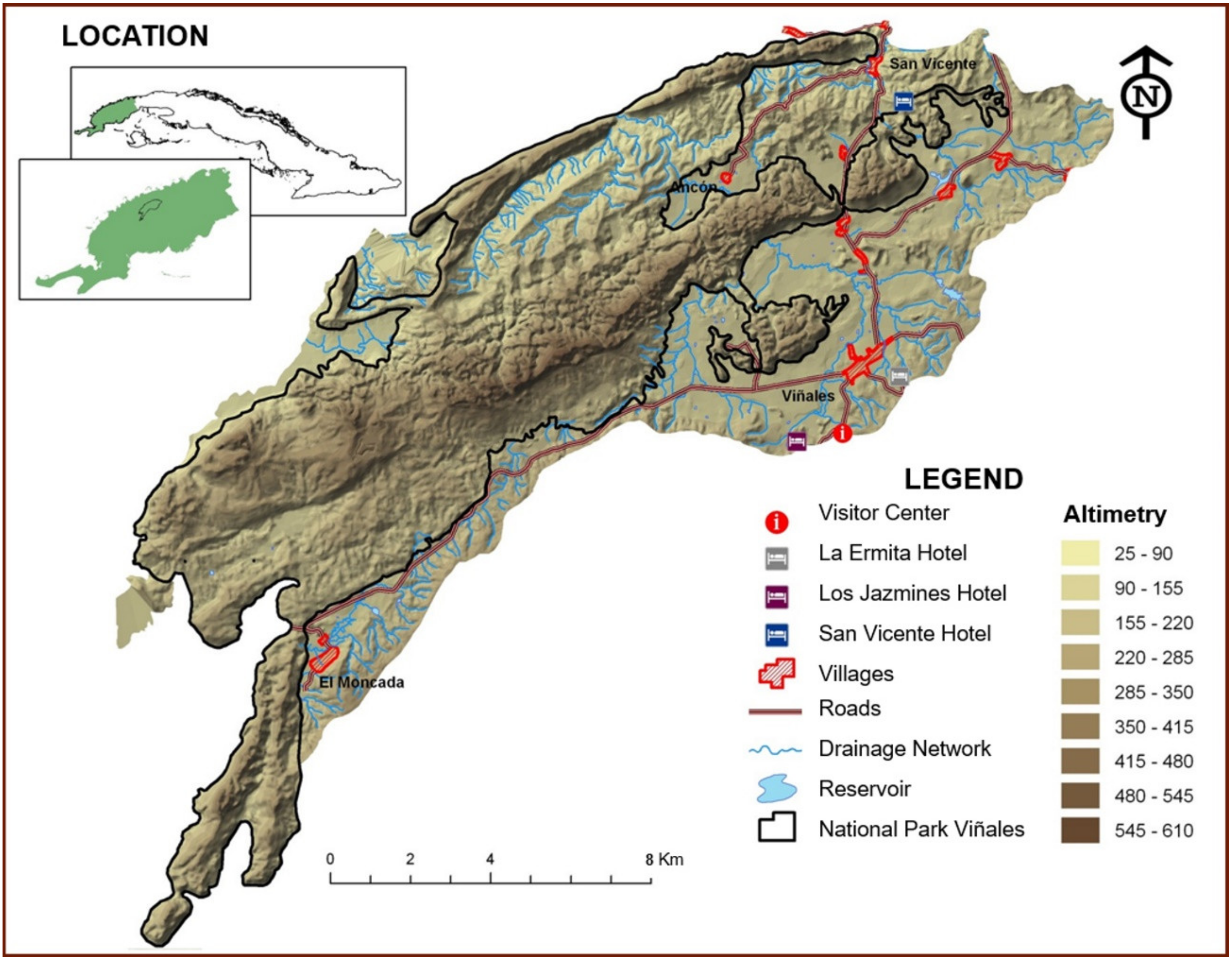
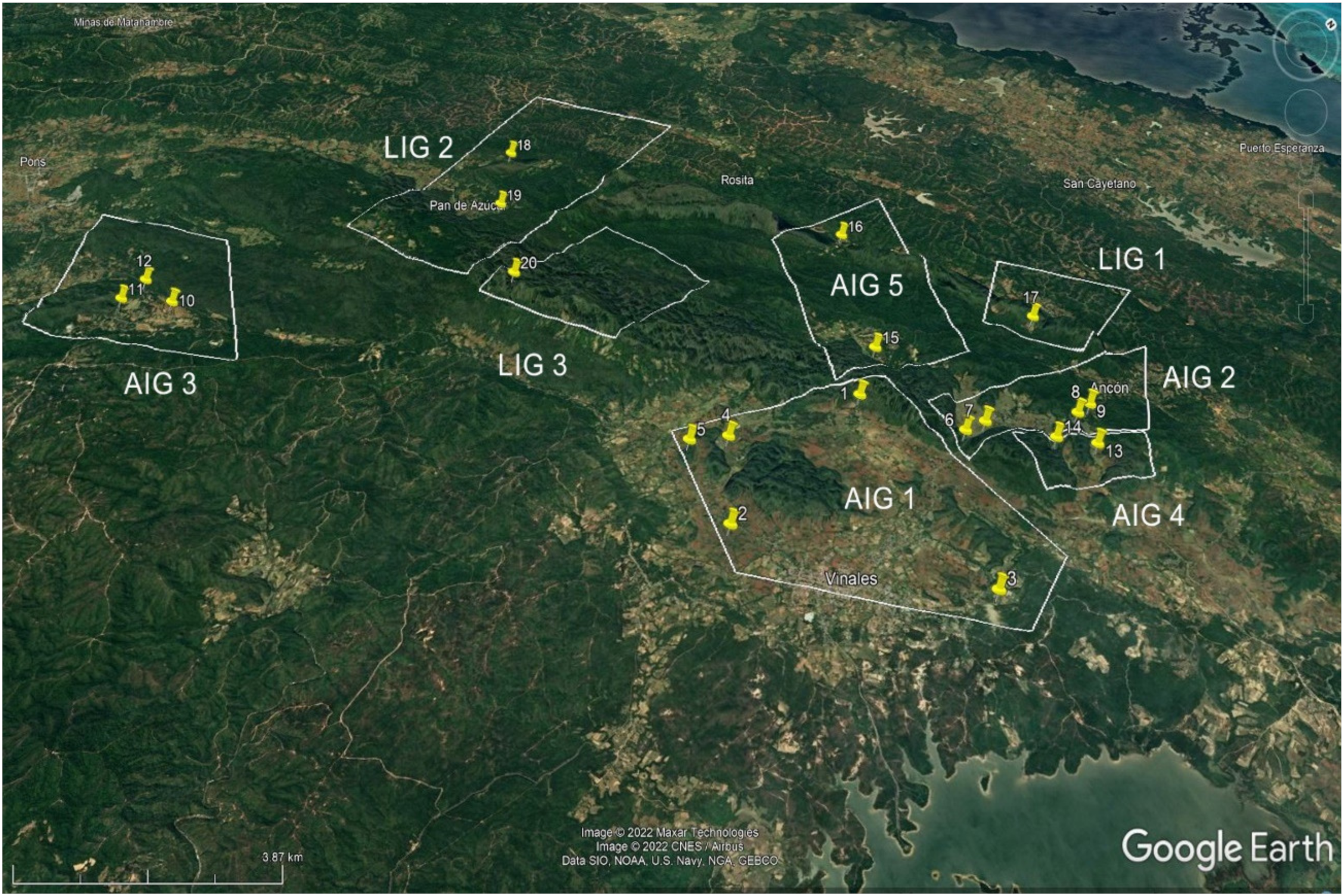
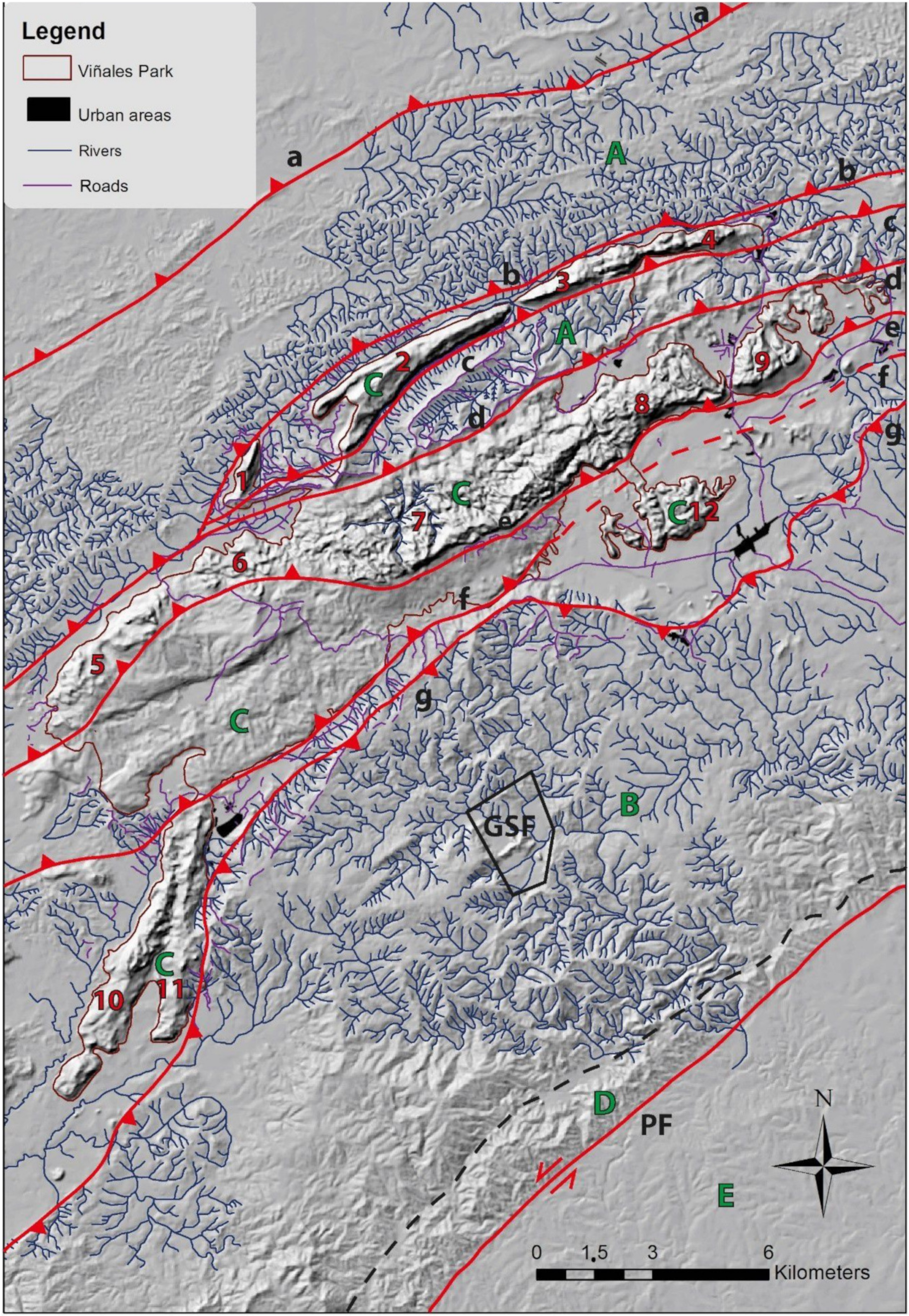


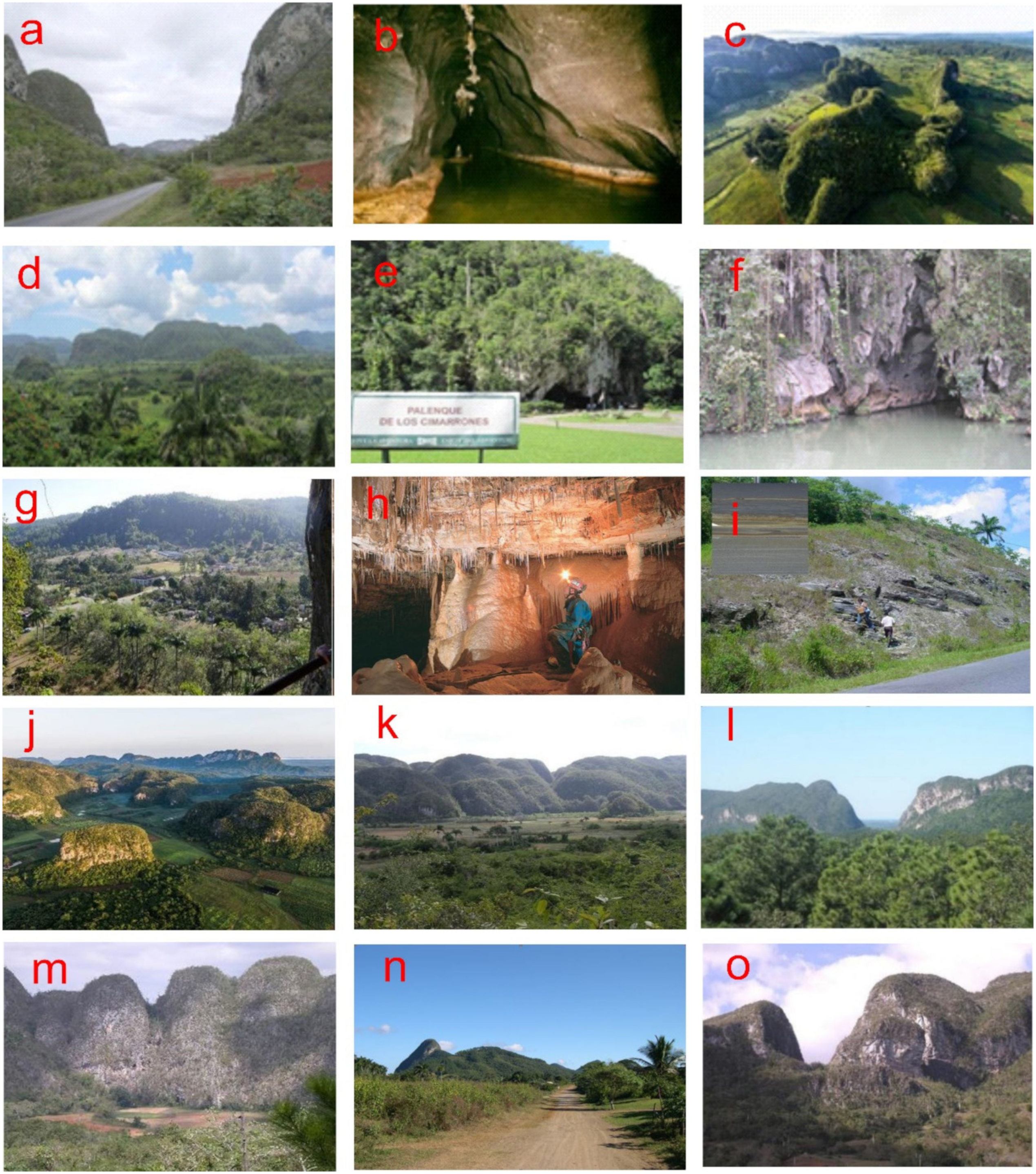

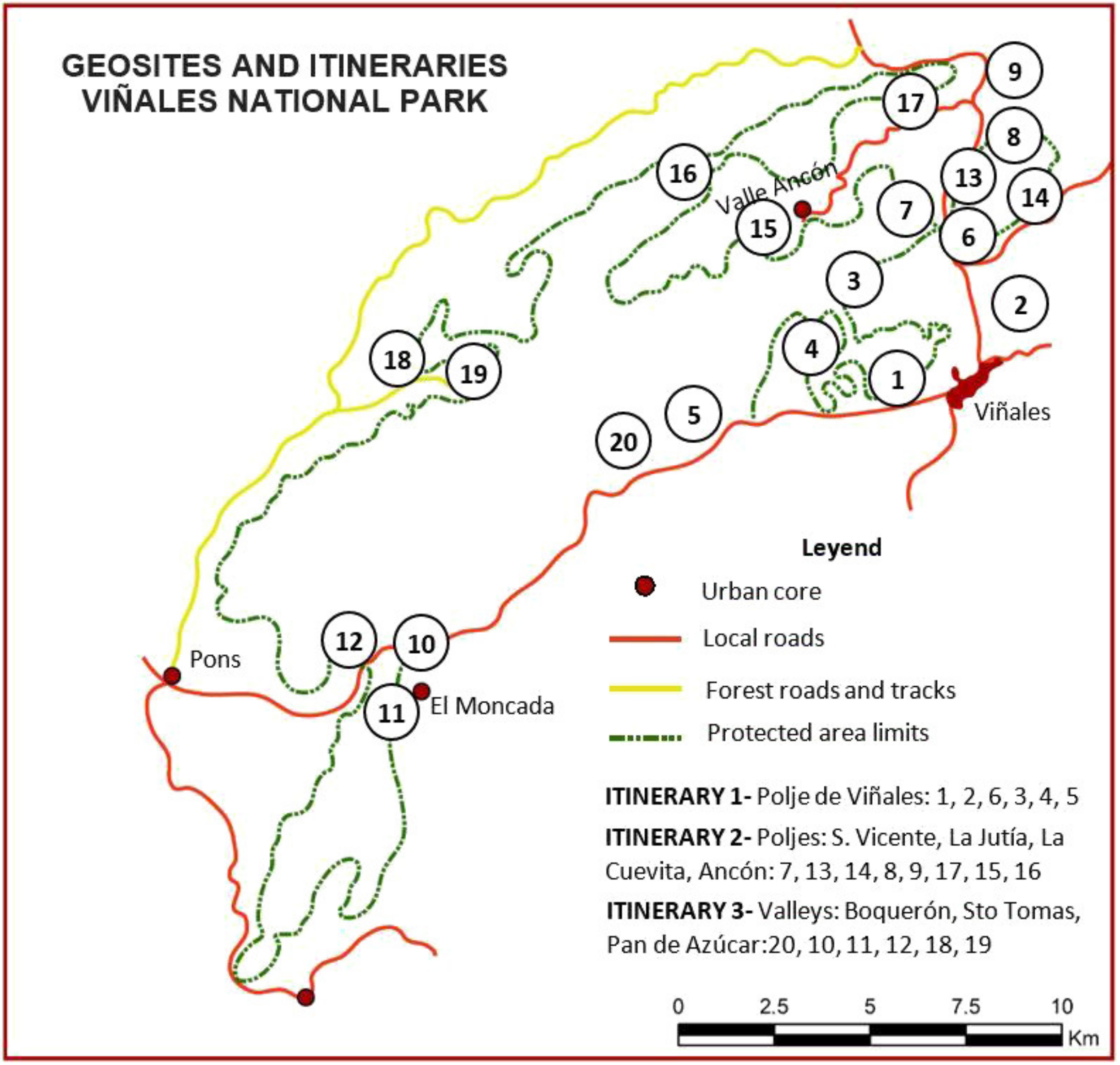

| GEOSITES | VIÑALES POLJE | SAN VICENTE POLJE | STO. TOMAS POLJE | LA JUTIA POLJE | ANCÓN POLJE | LA CUE-VITA POLJE | PAN DE AZUCAR Valley | Boq, INFIER-NO | ||||||||||||
|---|---|---|---|---|---|---|---|---|---|---|---|---|---|---|---|---|---|---|---|---|
| Viñales Valley | Dos Hermanas Valley | South | North | |||||||||||||||||
| 1 | 2 | 3 | 4 | 5 | 6 | 7 | 8 | 9 | 10 | 11 | 12 | 13 | 14 | 15 | 16 | 17 | 18 | 19 | 20 | |
| Representativeness | 4 | 1 | 2 | 2 | 1 | 2 | 1 | 2 | 2 | 2 | 4 | 4 | 2 | 2 | 2 | 2 | 2 | 2 | 1 | 2 |
| Character type locality | 1 | 0 | 1 | 1 | 1 | 1 | 2 | 1 | 1 | 2 | 2 | 2 | 1 | 2 | 2 | 2 | 2 | 2 | 1 | 1 |
| Degree of scientific knowledge | 4 | 0 | 1 | 2 | 0 | 2 | 2 | 2 | 2 | 2 | 4 | 2 | 2 | 1 | 2 | 1 | 1 | 2 | 2 | 4 |
| State of conservation | 2 | 2 | 2 | 2 | 2 | 2 | 2 | 1 | 1 | 2 | 2 | 2 | 2 | 2 | 2 | 2 | 2 | 2 | 2 | 4 |
| Viewing conditions | 4 | 4 | 1 | 4 | 4 | 4 | 2 | 2 | 2 | 4 | 2 | 2 | 2 | 1 | 4 | 2 | 4 | 2 | 2 | 4 |
| Rarity | 2 | 0 | 1 | 2 | 1 | 1 | 1 | 1 | 1 | 0 | 2 | 4 | 0 | 0 | 0 | 0 | 0 | 0 | 0 | 0 |
| Geological diversity | 4 | 2 | 2 | 4 | 2 | 2 | 2 | 2 | 1 | 2 | 2 | 2 | 2 | 2 | 4 | 2 | 4 | 2 | 1 | 2 |
| Educational use | 4 | 2 | 2 | 4 | 2 | 2 | 2 | 4 | 1 | 4 | 2 | 2 | 2 | 2 | 4 | 1 | 2 | 4 | 4 | 4 |
| Logistics infrastructure | 4 | 2 | 4 | 4 | 1 | 4 | 4 | 4 | 4 | 1 | 2 | 2 | 1 | 0 | 2 | 0 | 2 | 0 | 0 | 2 |
| Population density | 1 | 1 | 1 | 2 | 1 | 2 | 1 | 2 | 2 | 2 | 2 | 2 | 2 | 2 | 2 | 2 | 2 | 2 | 2 | 2 |
| Accessibility | 4 | 1 | 1 | 4 | 4 | 4 | 0 | 4 | 4 | 4 | 2 | 4 | 1 | 0 | 1 | 1 | 2 | 1 | 1 | 2 |
| Intrinsic fragility (geosite size) | 4 | 2 | 1 | 4 | 2 | 4 | 1 | 0 | 2 | 2 | 4 | 1 | 1 | 1 | 2 | 2 | 2 | 2 | 2 | 4 |
| Cultural/Natural elements | 4 | 2 | 4 | 2 | 4 | 2 | 2 | 4 | 4 | 2 | 4 | 4 | 2 | 2 | 2 | 2 | 2 | 4 | 4 | 2 |
| Beauty or spectacularity | 4 | 2 | 2 | 2 | 2 | 2 | 1 | 2 | 2 | 2 | 2 | 1 | 1 | 1 | 1 | 1 | 2 | 2 | 2 | 1 |
| Informative content/use | 4 | 2 | 2 | 2 | 1 | 2 | 1 | 4 | 1 | 2 | 4 | 2 | 2 | 1 | 1 | 2 | 4 | 2 | 2 | 2 |
| Potential for geotourism | 4 | 4 | 4 | 4 | 4 | 2 | 0 | 4 | 4 | 2 | 4 | 1 | 2 | 1 | 2 | 2 | 4 | 2 | 1 | 2 |
| Proximity to recreational areas | 4 | 2 | 1 | 4 | 2 | 2 | 2 | 1 | 1 | 1 | 0 | 0 | 0 | 0 | 0 | 0 | 0 | 0 | 0 | 0 |
| Socioeconomic environment | 0 | 1 | 0 | 0 | 1 | 2 | 2 | 2 | 2 | 2 | 2 | 4 | 2 | 2 | 2 | 4 | 4 | 4 | 4 | 4 |
| TOTAL | 58 | 30 | 32 | 49 | 35 | 42 | 28 | 42 | 37 | 38 | 46 | 41 | 27 | 22 | 35 | 28 | 41 | 35 | 31 | 42 |
| Scientific interest | 300 | 110 | 150 | 230 | 135 | 195 | 155 | 165 | 155 | 190 | 290 | 290 | 160 | 145 | 210 | 155 | 195 | 170 | 120 | 230 |
| Educational interest | 350 | 165 | 205 | 325 | 215 | 260 | 180 | 295 | 225 | 255 | 220 | 255 | 150 | 120 | 240 | 120 | 220 | 195 | 175 | 240 |
| Touristic–Cultural interest | 345 | 195 | 170 | 270 | 215 | 270 | 125 | 245 | 230 | 220 | 270 | 200 | 140 | 100 | 155 | 170 | 260 | 200 | 195 | 230 |
| TOTAL | 1015 | 470 | 525 | 825 | 565 | 725 | 460 | 705 | 610 | 665 | 780 | 745 | 450 | 365 | 605 | 445 | 675 | 565 | 490 | 700 |
| Value of Geomorphological domain | 3400 | 2300 | 2190 | 815 | 1050 | 675 | 1055 | 700 | ||||||||||||
Disclaimer/Publisher’s Note: The statements, opinions and data contained in all publications are solely those of the individual author(s) and contributor(s) and not of MDPI and/or the editor(s). MDPI and/or the editor(s) disclaim responsibility for any injury to people or property resulting from any ideas, methods, instructions or products referred to in the content. |
© 2023 by the authors. Licensee MDPI, Basel, Switzerland. This article is an open access article distributed under the terms and conditions of the Creative Commons Attribution (CC BY) license (https://creativecommons.org/licenses/by/4.0/).
Share and Cite
Goy, J.L.; Corvea, J.L.; de Bustamante, I.; Martínez-Graña, A.M.; Díaz-Guanche, C.; Zazo, C.; Dabrio, C.J.; González-Delgado, J.Á.; Blanco, A.; Nieto, C.E. Geomorphological Heritage in Viñales National Park (Aspiring UNESCO Geopark): Geomatic Tools Applied to Geotourism in Pinar del Río, Cuba. Sustainability 2023, 15, 5704. https://doi.org/10.3390/su15075704
Goy JL, Corvea JL, de Bustamante I, Martínez-Graña AM, Díaz-Guanche C, Zazo C, Dabrio CJ, González-Delgado JÁ, Blanco A, Nieto CE. Geomorphological Heritage in Viñales National Park (Aspiring UNESCO Geopark): Geomatic Tools Applied to Geotourism in Pinar del Río, Cuba. Sustainability. 2023; 15(7):5704. https://doi.org/10.3390/su15075704
Chicago/Turabian StyleGoy, José Luis, Jose Luis Corvea, Irene de Bustamante, Antonio Miguel Martínez-Graña, Carlos Díaz-Guanche, Caridad Zazo, Cristino J. Dabrio, José Ángel González-Delgado, Alberto Blanco, and Carlos E. Nieto. 2023. "Geomorphological Heritage in Viñales National Park (Aspiring UNESCO Geopark): Geomatic Tools Applied to Geotourism in Pinar del Río, Cuba" Sustainability 15, no. 7: 5704. https://doi.org/10.3390/su15075704
APA StyleGoy, J. L., Corvea, J. L., de Bustamante, I., Martínez-Graña, A. M., Díaz-Guanche, C., Zazo, C., Dabrio, C. J., González-Delgado, J. Á., Blanco, A., & Nieto, C. E. (2023). Geomorphological Heritage in Viñales National Park (Aspiring UNESCO Geopark): Geomatic Tools Applied to Geotourism in Pinar del Río, Cuba. Sustainability, 15(7), 5704. https://doi.org/10.3390/su15075704








